Tennis Court – Dimensions, Surfaces & Construction
Tennis courts are nowadays spread all over the world. Depending on the region and facility, they have different surfaces. Basically they are equipped with one of the four main surfaces, clay, hard court, grass or carpet. In the course of time, many other variations have been added, such as courts with granules.
The only thing that hasn’t changed in the last decades on the tennis court are the dimensions of the court. These standards ensure that the same playing conditions remain on all courts worldwide. However, many players are unaware that the surface has a significant influence on playing style.
For this reason, we have created a complete overview of the tennis court for you. Here you can find out, among other things, what the dimensions of a tennis court are and how the surface affects the game. In addition, there are tips on the construction and maintenance of a tennis court.
Tennis Court Dimensions
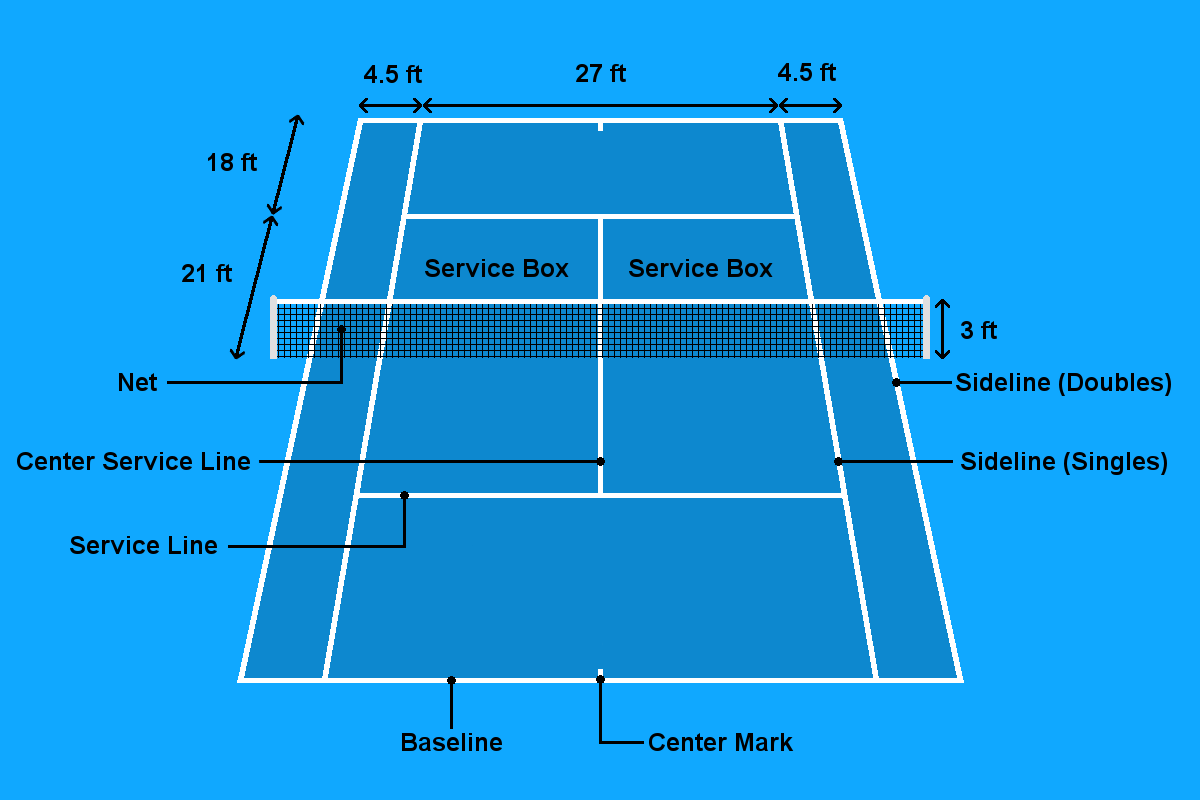
In tennis, the court is rectangular and is bounded by the baselines and sidelines. In principle the length is 78 ft. The width of the tennis court varies depending on the game variant.
If you play singles, it is 27 ft. In comparison, the doubles court is slightly larger. With the doubles alleys, the width here is 36 ft.
In the middle there is a net which divides the court into two equally sized halves. The net is attached to both net posts and has a height of 3 ft in the middle of the court.
The lines that run parallel to the net at a distance of 21 ft. are called service lines. In addition, a center service line extends from the net to the service line on each side.
It divides this area into two equal halves, which are known as the service boxes. Because of their formation, the service line and the centre service line are together also called the “T”.
To extend the center service line, there is a small mark on the baseline. It shows the player the middle of the baseline.
Tennis Court Surfaces
As briefly mentioned above, these four types of tennis courts are the most common on tennis facilities.
- Clay Court
- Hard Court
- Grass Court
- Carpet Court
Apart from their playing characteristics, they also differ in their basic structure and court maintenance.
Clay Court
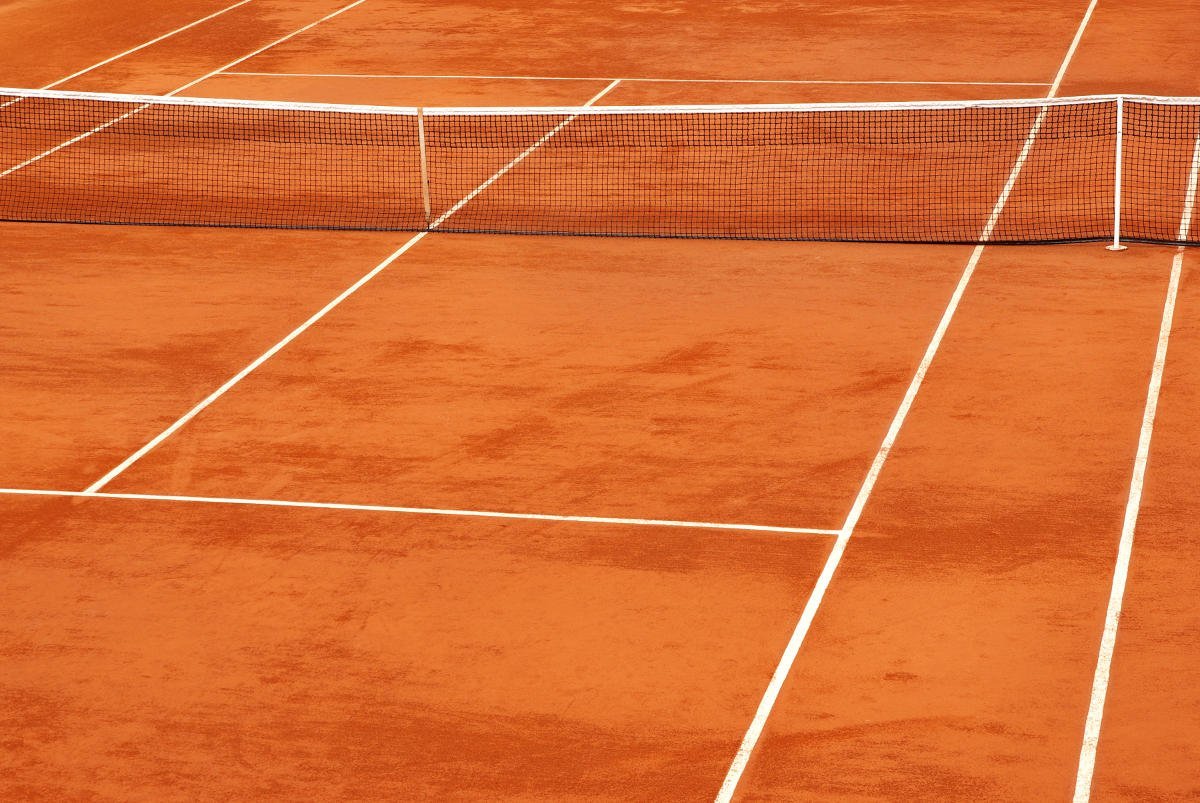
In Europe and in South America you can see mainly clay courts. Usually this surface is used for outdoor tennis courts. Occasionally, however, there are also indoor tennis clay courts. Characteristic for the clay court is its red to orange surface.
Of all four types of courts, the game on the clay court is the slowest. This is because the tennis ball digs deep into the clay when it touches the ground before bouncing back up. The friction between the grains of clay and the felt additionally slows down the ball.
The clay court has the second property that the ball bounces highest off the ground. In combination with topspin, these balls that are very difficult to return. Sometimes you may even have to hit the ball almost at head height to get it into the court.
These characteristics are the main reason why rallies on the clay court take considerably longer. Often you can still manage to get to distant balls and keep yourself in the game.
In general, you need to be in good shape to play longer matches on this court. Especially in hot weather, rallies are quite demanding.
On the other hand, the clay court has the advantage that it is very easy on the joints due to the loose surface. This significantly reduces the risk of injuries. In addition, the soft ground gives you the possibility to slide on the court with your tennis shoes, so that you can move around even easier.
Overall, the clay court is perfect for baseline players who can hit the ball with the necessary topspin. It is also helpful if you have powerful shots so that you can put pressure on your opponent directly from the baseline. For serve and volley players this surface is rather unsuitable.
Hard Court
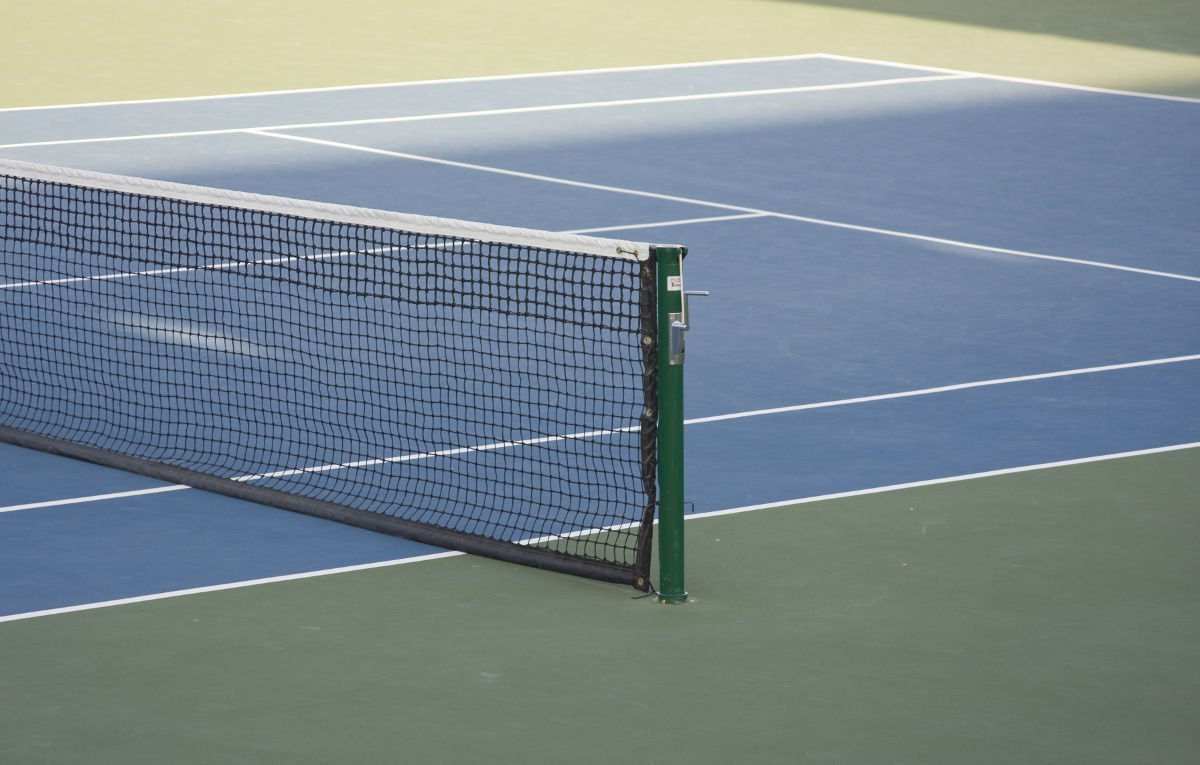
On the other hand, the hard court is very popular in North America. There you will find countless tennis facilities that are equipped with this surface. What makes the hard court so special?
First of all, the fact that it can be used indoors as well as outdoors. Basically, a layer of concrete or asphalt forms the foundation for the hard court.
The foundation is then covered with several layers of a mixture of acrylic and rubber. This surface gives the hard court its typical look. As a rule, a light blue is chosen as the colour, as the contrast to the yellow ball is highest.
While the clay court has a rough structure, the hard court has a smooth surface. This means that the ball hardly loses any speed through friction when it touches the ground. The hard court is therefore a faster surface than the clay court.
In general, the bounce of the ball depends on the composition of the surface of the hard court. However, compared to the clay court, the ball always bounces flatter on the hard court.
Another advantage of the smooth surface is that the ball has a constant bounce, which makes it easier to calculate the flight curve. On clay, the ground has unevenness which can cause the ball to bounce in other directions.
However, the hard court also has the downside that its top layer is impermeable to water. This means that it is not possible to play in the wet, as you could slip on the ground.
This looks different on a clay court. In light rain there are no restrictions because the water simply seeps into the sand. With large puddles the game is of course not possible.
As a tennis player you should also keep in mind that playing on a hard court is more prone to injuries. For example, your joints are exposed to a lot of stress when jumping because the ground is relatively hard. In addition, your shoes and balls are subject to more wear.
In principle, the hard court is a very dynamic surface, which is particularly suitable for more aggressive baseliners. Players with a powerful serve also benefit from this surface.
Grass Court
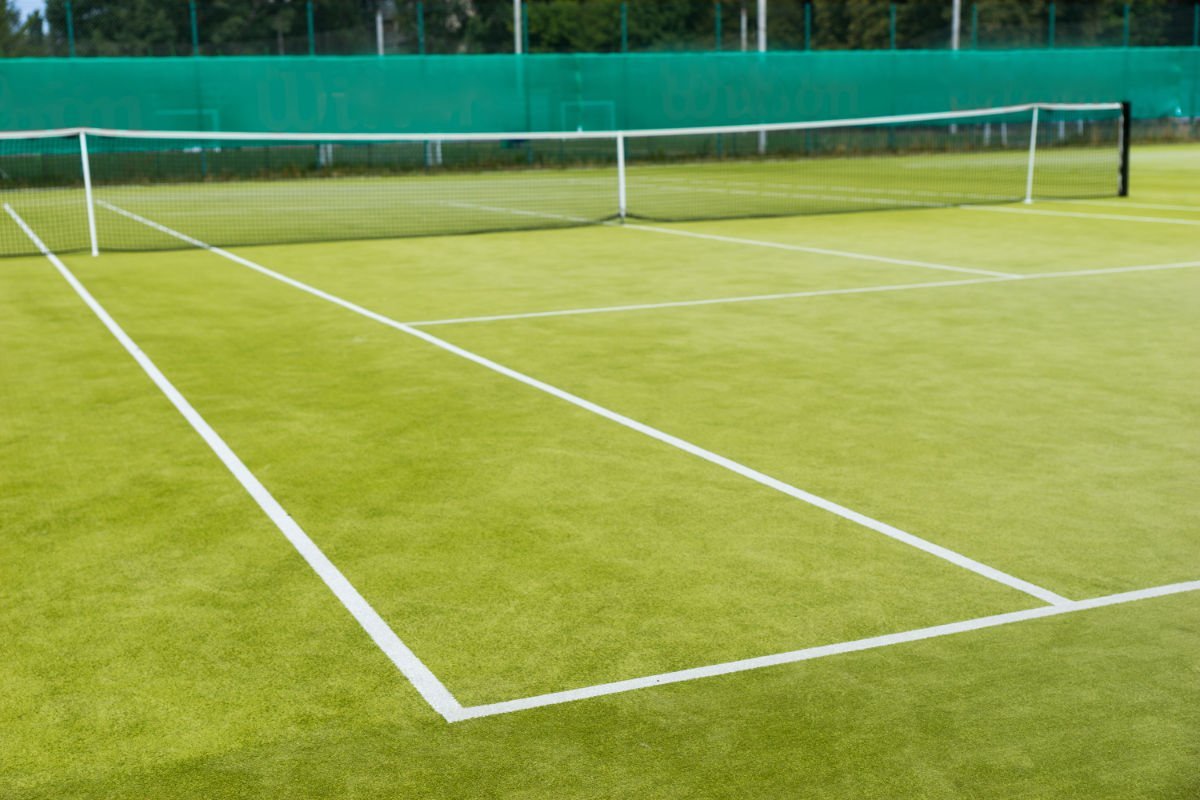
Grass courts are particularly common in England and Australia. These green tennis courts have a long history behind them, as tennis was initially played exclusively on grass. Today, however, grass courts have become rarer in other parts of the world.
There are essentially two types of grass courts, one is a natural grass court and the other is an artificial grass court. At the moment, most tennis courts still have natural grass, although this is increasingly being replaced by synthetic grass.
If you compare all surfaces, the game is by far the fastest on a grass court. The speed of the ball depends on the height of the blades of grass. The longer the grass is, the more the ball is slowed down by the blades of grass.
In addition to the high speed, the ball also bounces very flat on the grass. The soft ground acts as a kind of cushion which absorbs shocks optimally . Therefore, the grass court is also considered to be very easy on the joints.
These characteristics mean that the majority of rallies on grass are kept relatively short. Statistically speaking, rallies hardly last longer than 10 shots. Furthermore, you need a good ability to react to the fast balls.
Similar to the hard court, the grass court is unplayable in wet conditions. Since the grass is a bit slippery even without water, the risk of injury in the rain would be even higher.
By and large, matches on the grass court are extremely fast. That’s why it’s primarily strong service players who feel comfortable on the grass. Serve-and-volley players also perform very solidly on this surface.
Carpet Court
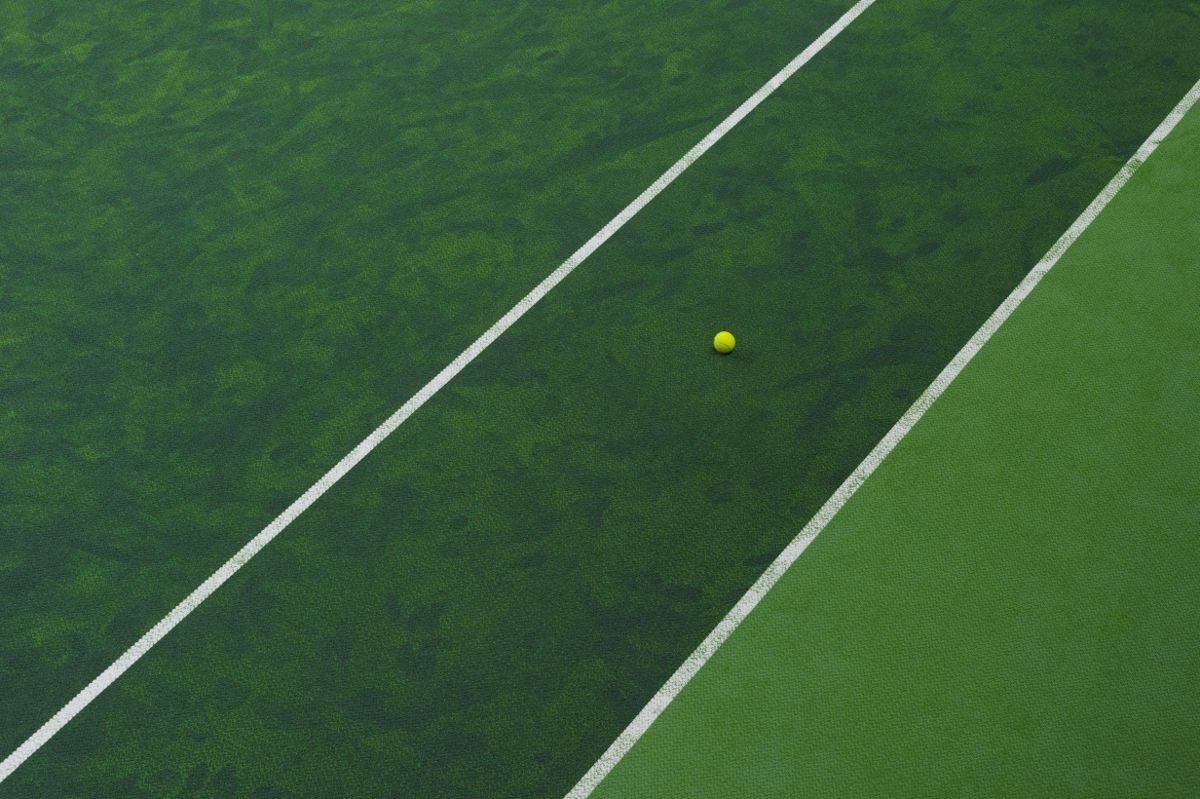
The fourth type of tennis court is the carpet court. Since this type of surface does not tolerate wetness or other external weather conditions, it is specially designed for indoor use.
Depending on the tennis hall, the carpet is made of a different material. For example, the fabric “velour” is very popular for indoor floors. Because it has a soft surface and is available in many colour combinations.
From the playing style you can imagine the carpet court as a mixture of hard court and grass court. More precisely, in this case the ground is softer than the hard court, but harder than the grass court. For this reason, the ball bounces higher than on the grass court and has a slightly faster speed than on the hard court.
In addition, you should know that the surface of the carpet is extremely grippy. In practice, it is not possible to slide on the ground because you are slowed down directly by the material. So there is an increased risk of injury. Therefore, playing on the carpet is relatively unusual for many tennis players at the beginning.
All in all, the carpet court is ideal for baseline players who like to come to the net occasionally. As on the grass court, quick reactions during the rally are helpful.
Compared to other surfaces, however, carpet courts only make up a small part of all tennis courts. In the professional sector, even tournaments are no longer played on carpet.
For men, it was the ATP that announced the end of the surface in 2009. In women’s tennis, tournaments ran until 2018 before the carpet court was replaced by the hard court.
How to Build a Tennis Court
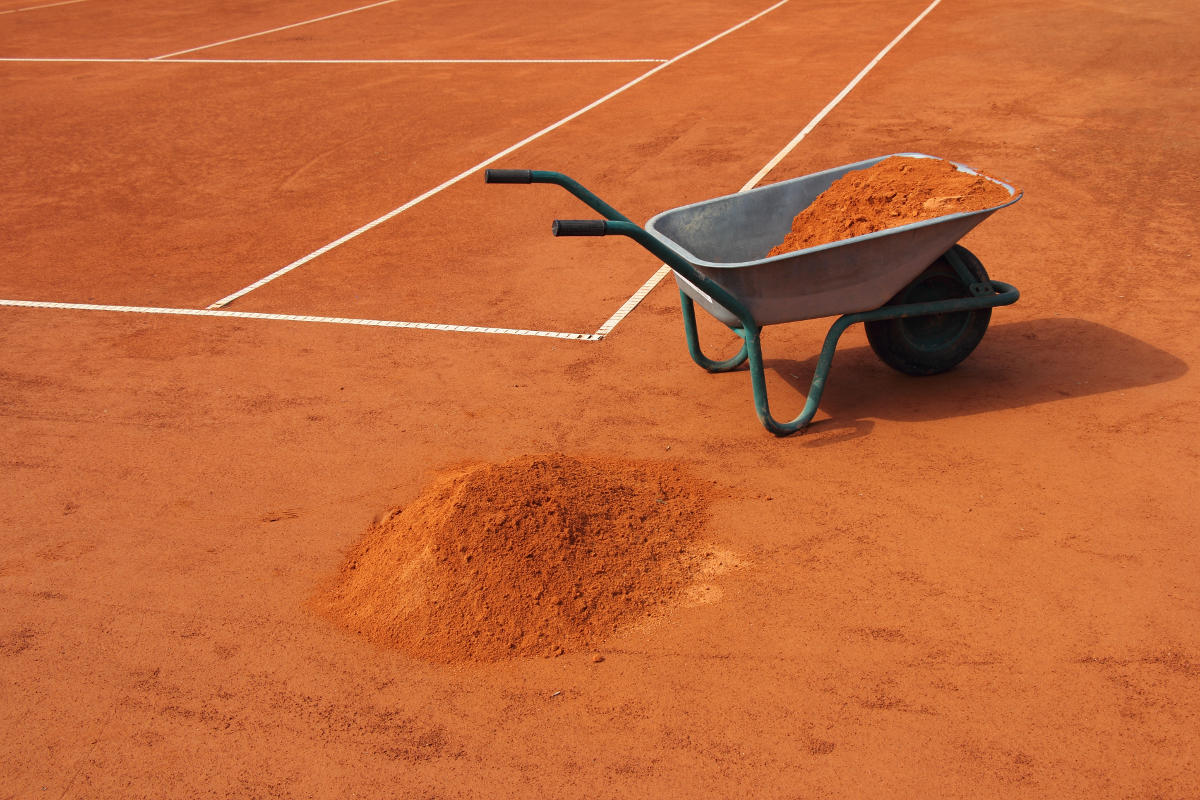
You always wanted to know how a tennis court is built or are already in the planning stage? Then you can get some tips for tennis court construction here. The following steps will show you how to build a clay court.
Planning
First of all you should of course think about where you want to build the tennis court. Make sure that you plan a sufficiently large area. A tennis court is only 36 x 78 ft., but you have to take into account the outer zones.
More precisely, the distance from the baseline to the fence should be at least 21 ft. In addition, the distance from the outermost side line to the fence should be at least 12 ft. All in all, you need an area of 60 x 120 ft. for a tennis court.
Before you start building, you should make sure you have a building permit. It is best to ask your local authority.
Materials
You need the following materials to build a tennis court:
- Drainage pipe
- Gravel
- Lava stones grain size 0-48 mm
- Lava stones grain size 0-32 mm
- Lava stones grain size 0-16 mm
- Brick dust grain size 0-2 mm
- Tennis net including net posts
- Tennis lines
- Wire mesh fence including posts
When you have all the materials together, you’re ready to start the construction.
Construction Process
In general, a tennis court is composed of five layers. These are arranged in order from bottom to top:
- Building ground
- Filter layer: 4 inches
- Base course: 6 inches
- Dynamic layer: 2.5 inches
- Top layer: 1 inch
In the first step you mark the area for the tennis court and then dig the ground up to a depth of 14 inches. Provide the ground with a cross slope of 0.5%, so that the rainwater is later drained off in the best possible way. It is important that you maintain this inclination for each subsequent layer.
Then compact the subsoil with a roller. Then anchor the ground sockets for the two net posts in the subgrade. Furthermore, the drainage system requires a drainage which is still installed in the ground. To do this, you dig a trench in the ground, insert the drainage pipes and fill the free space with gravel.
On the subsoil you now pour a filter layer of lava stones with a grain size of 0-48 mm. After compacting, this layer should be 4 inches thick.
Now lay a 6 inches high base layer over the filter layer. It consists of lava stones with a grain size of 0-32 mm. Press the stones together with the roller to create a stable foundation for the tennis court.
The next step is the dynamic layer. It consists of 0-16 mm lava stones and should have a compacted layer thickness of 2.5 inches. If you have also applied this layer, only the top layer is still missing.
The top layer has a height of 1 inch and consists of the typical red brick dust with a grain size of 0-2 mm. Make sure that you do not pour out all the brick dust at once, but spread it out gradually.
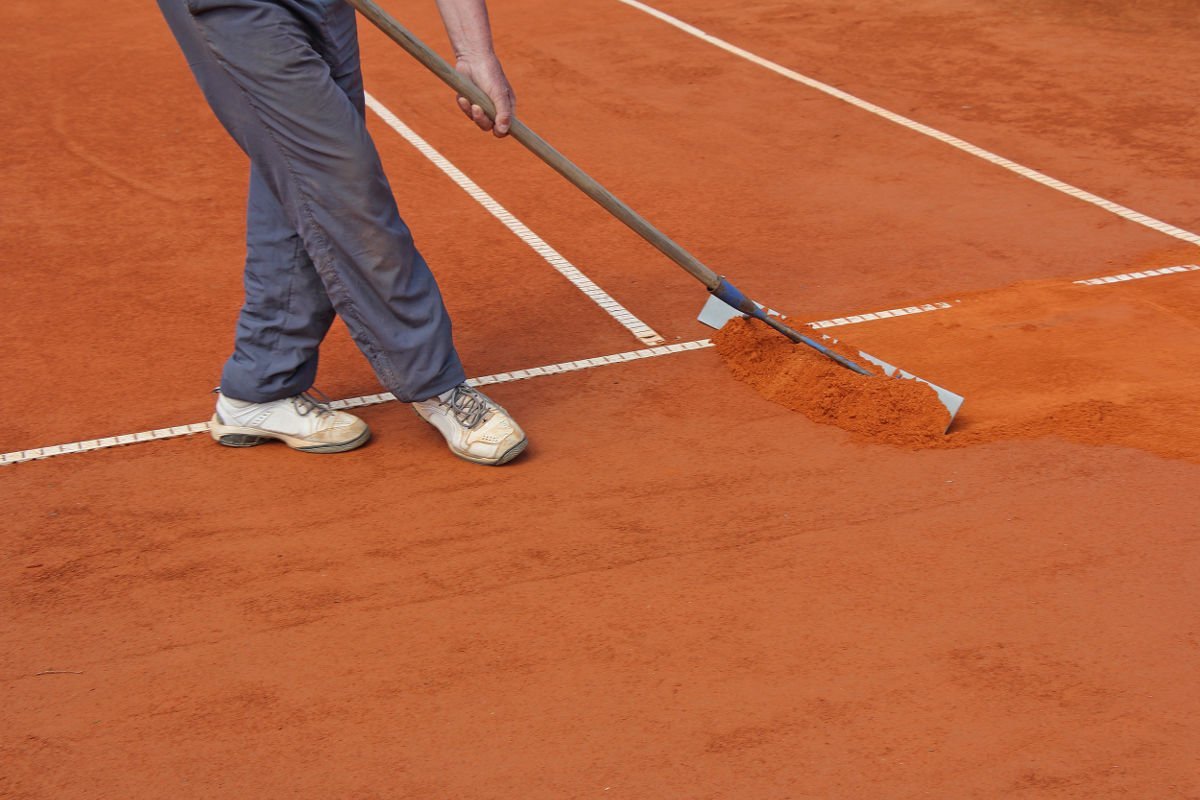
First apply a 1/2 inch high layer evenly on the pitch and compact it with the roller. Sprinkle another layer of brick dust over it and spray it with a large amount of water. With this you strengthen the brick dust additionally.
Once the layer is dry, you spread the rest of the brick dust on the square and roll the layer. Then you lay out the lines and hammer them into the clay.
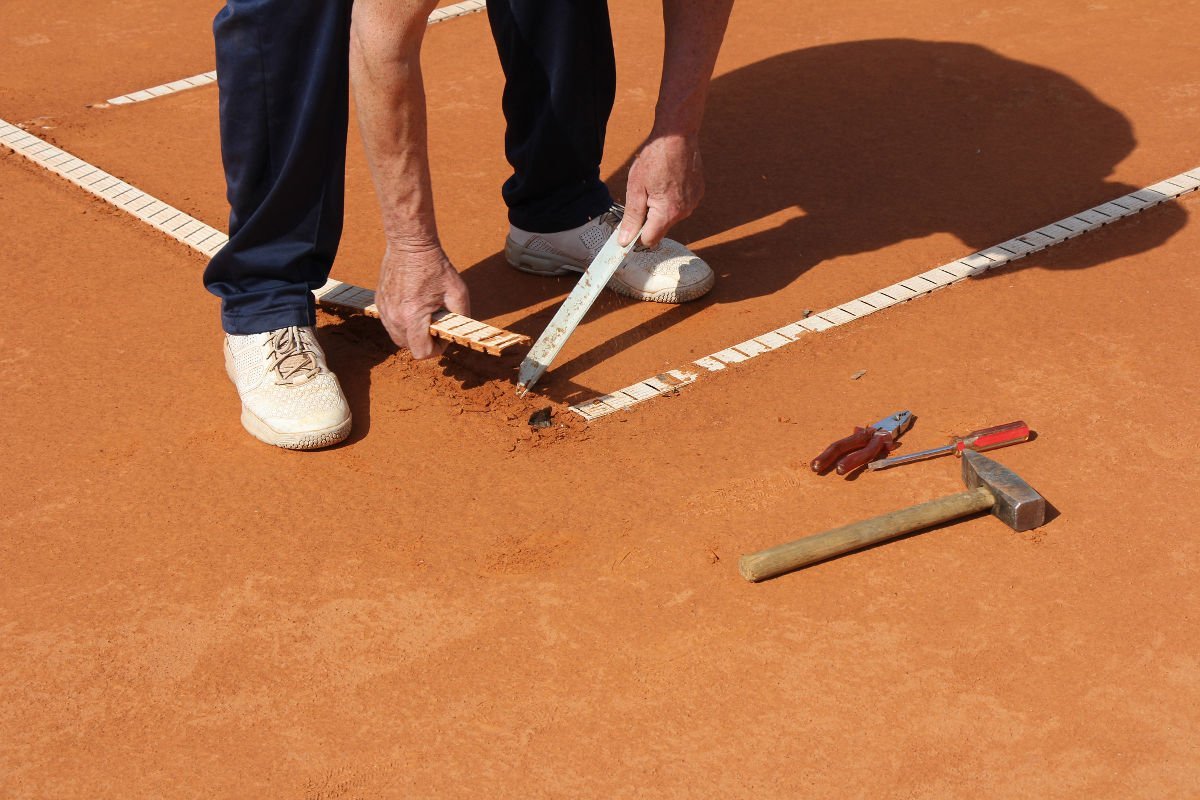
Finally, you push the net posts into the ground sockets and hang up the tennis net. In the last step you build up the bridle around the tennis court.
Now the new tennis court is finished and ready to be played on for the first time.
Tennis Court Equipment
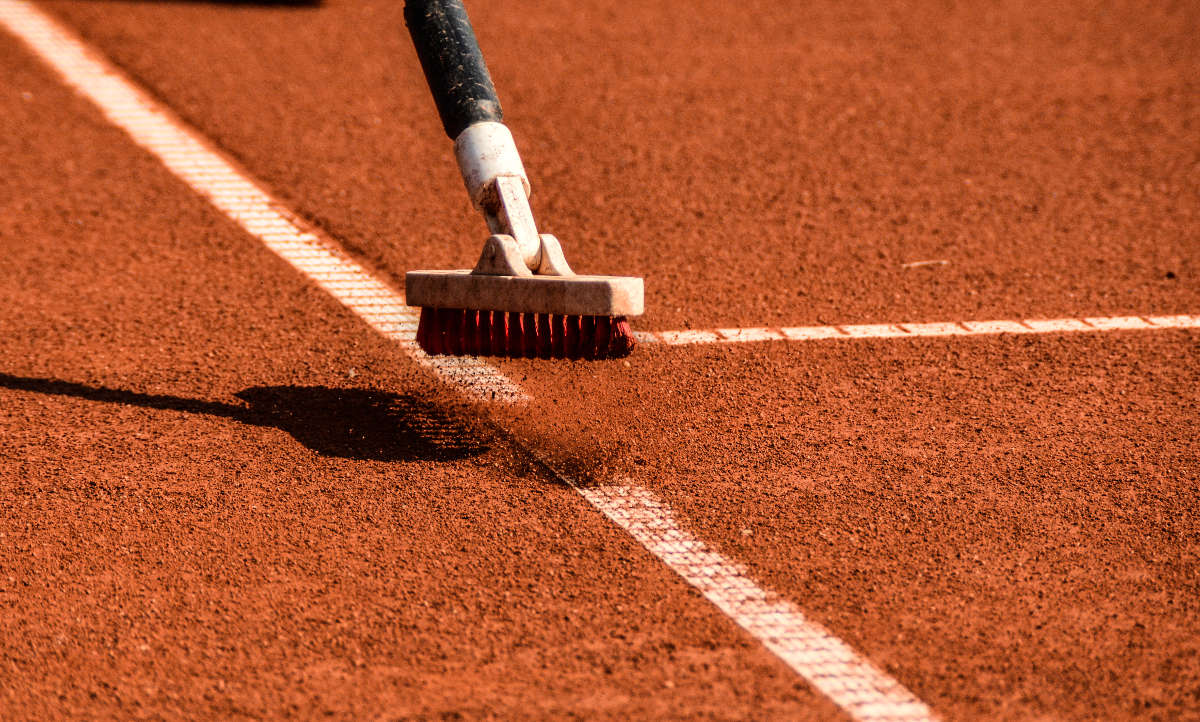
Depending on your wishes, you can also equip the tennis court with other accessories. This not only improves the playing experience, but also simplifies the maintenance of the court. These tennis court accessories could be helpful for your court.
- Sprinkler
- Drag net
- Line sweeper
- Bench
- Umpire chair
- Scoreboard
- Windscreen
- Divider net
Tennis Court Maintenance
Whether a tennis court has just been built or is already a few years old, it needs regular maintenance. Otherwise, the surface will continue to wear down until the court is no longer playable. That’s why you should consider these points for the care and maintenance of the tennis court.
Especially dryness and heat is a big problem for a clay court. If the surface layer is too dry, it can happen that the brick dust will be blown away in the next strong gust of wind.
This not only makes playing on the course tiring, but also causes considerable damage to the course. Check the court at regular intervals and water it if necessary. Among other things, you can also use automated sprinkler.
In addition, after each match or training session, you should drag the court with the net. In this way you will wipe out the footprints that were left when you played. Afterwards you sweep the lines of the court with the broom.
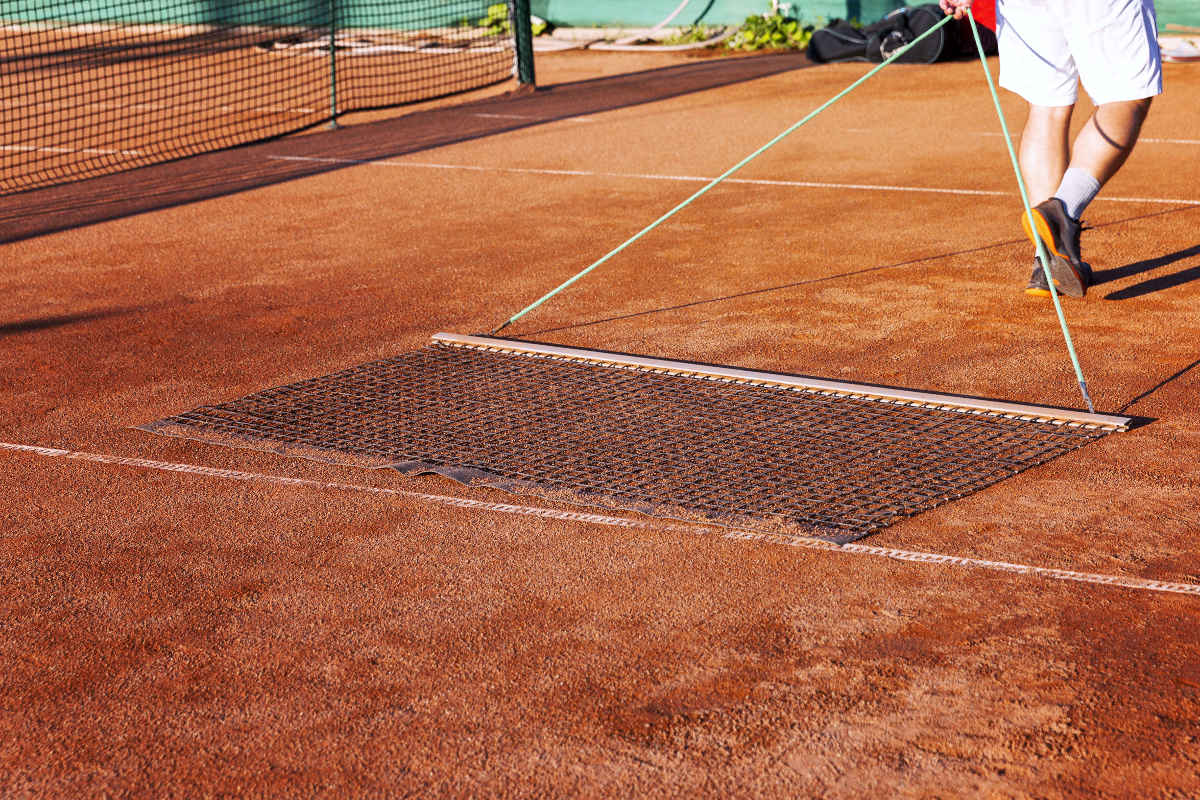
Over time, it is normal for unevenness to form on the surface, especially in the baseline area. As the sand is removed here, it collects in the outer corners of the pitch. In this case, you can use the plywood to redistribute the sand on the court to eliminate the notches.